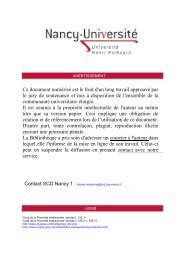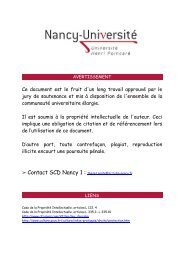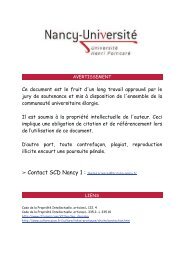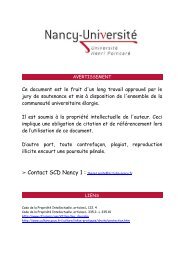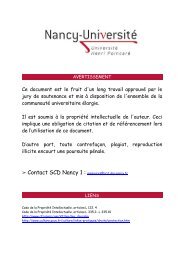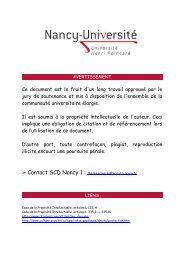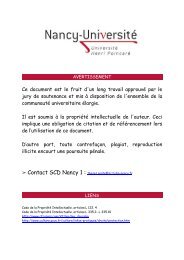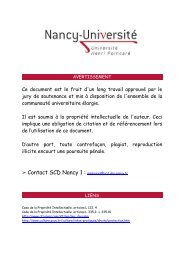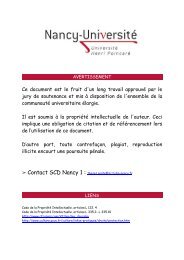Ce document numérisé est le fruit d'un long travail approuvé par le ...
Ce document numérisé est le fruit d'un long travail approuvé par le ...
Ce document numérisé est le fruit d'un long travail approuvé par le ...
You also want an ePaper? Increase the reach of your titles
YUMPU automatically turns print PDFs into web optimized ePapers that Google loves.
18<br />
C. Huin et al. / Biology ofthe <strong>Ce</strong>1l94 (2002) 15-27<br />
Tab<strong>le</strong> 1<br />
Primers se1ected for SI nuc<strong>le</strong>ase protection assay.<br />
Probe Primer up (5'-3') Primer down (5'-3') Length (bp) Reference<br />
hPPARa GCCCAGGCTGAAGCTCAGGG GACACGGAAAGCCACTCTTGC 244 Sher et al. (1993)<br />
hPPARYl TCGGACCCCGAGCCCGAG TCAAACGAGAGTCAGCCTTTAAAC 133 Fajas et al. (1997)<br />
hPPARY2 CCCATCTCTCCCAAATATTT CACAGAGATCGCATTCGGCCC 282 Fajas et al. (1997)<br />
hPPARY3 GAAAGAAGCCGACACTAAACCAC ACACCTCATCTTTACGACCTCTTC 222 Fajas et al. (1998)<br />
G3PDH CCCATCACCATCTTCCGA GGAAACTGTGGCCTGTAG 380 Tso et al. (1985)<br />
and down primers are indicated in tab<strong>le</strong> 1. Amplification<br />
was calTied out by 30 cyc<strong>le</strong>s (95 oC, 30 s; 60 oC, 30 s;<br />
72 oC, 30 s) foUowed by an extension step at 72 oC for<br />
5 min. After purification, the PCR fragments were cloned<br />
into the pBluescript II KS+ vector to obtain the recombinant<br />
plasmids pKS+/PPARa, pKS+/PPARYJ, pKS+/PPARY2 and<br />
pKS+/G3PDH then sequenced. The PPARYJ probe (133 nt)<br />
contained exon Al (94 nt) and a <strong>par</strong>t of exon El (39 nt)<br />
according to the definition of the genomic structure of the<br />
human PPARy gene by Fajas et al. (1998). The PPARY2<br />
probe (282 nt) spanned exon B (243 nt) and the 5' end of<br />
exon 1 (39 nt) whereas the PPARY3 probe (222 nt) contained<br />
the fuU<strong>le</strong>ngth exon A2 (76 nt) and exon 1 (146 nt).<br />
The plasmids were linearized as foUows: pKS+/PPARYJ<br />
and pKS+/PPARY2 with Bam Hl, pKS+/PPARY3 and<br />
pKS+/G3PDH with Eco RI, then labe<strong>le</strong>d with (a_ 32 p] dCTP<br />
by down extension using Taq polymerase and the specifie<br />
primer (Tab<strong>le</strong> 1). Total RNA (5 [log) extracted from Caco-2<br />
ceUs at different durations of culture, was first treated by<br />
RNAse free RQ-1 DNAse (Promega, La JoUa, CA, USA)<br />
then hybridized with the labe<strong>le</strong>d sing<strong>le</strong>-stranded DNA<br />
probes (10 5 cpm pel' samp<strong>le</strong>) at 60 oC for 16 h. Non<br />
hybridized DNA was dig<strong>est</strong>ed by SI nuc<strong>le</strong>ase (50 U pel'<br />
samp<strong>le</strong>) for 1 h at 37 oC then extracted by phenol!<br />
chloroform procedure (Sambrook et al., 1989). The<br />
DNAIRNA hybrids were resolved by e<strong>le</strong>ctrophoresis on a<br />
5% polyacrylamide gel under denaturing conditions. Then,<br />
the gel was exposed to a X-OMAT Kodak film for 24 h. The<br />
resulting bands were quantified by densitometry and the<br />
values were standardized versus the cOlTesponding G3PDH<br />
values.<br />
2.8. Statistical analysis<br />
Data concerning the actJVlt<strong>le</strong>s of sucrase-isomaltase,<br />
alkaline phosphatase, AOX and catalase were expressed as<br />
means ± standard deviations from three independent experiments.<br />
Densitometric analyses of SI nuc<strong>le</strong>ase protection<br />
assay blots were calTied out from four independent experiments.<br />
Evaluation of statistical significances was assessed<br />
using analysis of variance (ANOVA) and the Fisher protected<br />
<strong>le</strong>ast significant difference t<strong>est</strong> (multip<strong>le</strong> com<strong>par</strong>isons)<br />
(Winer, 1971). Statistical significance is indicated in<br />
each figure.<br />
3. Results<br />
3.1. Assessment of Caco-2 cel! differentiation<br />
The specifie activities of sucrase-isomaltase and alkaline<br />
phosphatase (two brush border membrane enzymes), AOX<br />
and catalase (two peroxisomal enzymes) were determined in<br />
homogenates of Caco-2 ceUs cultured for 5, 10 and 15 days.<br />
As shown in tab<strong>le</strong> 2, the specifie activities of sucraseisomaltase<br />
and alkaline phosphatase increased steadily during<br />
ceU culture. They were increased by 2.3 and 5.7 fold,<br />
respectively at day 15 of culture when com<strong>par</strong>ed to control<br />
values (5 days of culture). The pattern of peroxisomal<br />
enzymes was somewhat different as AOX and catalase<br />
specifie activities increased by 1.7 and 3 fold, respectively,<br />
between day 5 and day 10 of ceU culture then remained<br />
constant.<br />
Using specifie polyclonal antibodies, the protein <strong>le</strong>vels of<br />
villin, a mo<strong>le</strong>cular marker of brush border development, and<br />
of AOX, PBE, catalase and PMP70 (both peroxisomal<br />
proteins) were analyzed by W<strong>est</strong>ern blotting. An unique<br />
band with mo<strong>le</strong>cular weight of 90 kDa was detected for<br />
villin in Caco-2 ceU homogenates. Its intensity increased<br />
about 2.3 fold foUowing 15 days of culture (Fig. 1). Whatever<br />
the duration of culture, three bands were immunodetected<br />
for AOX at 65.6, 56 and 42 kDa, respectively. This is<br />
consistent with previous w<strong>est</strong>ern blot data for this enzyme<br />
(Duclos et al., 1997). Scanning densitometry of the intensity<br />
of the 56 kDa subunit revea<strong>le</strong>d a graduaUy increase giving<br />
a maximum of about 3.3 fold at 15 days of culture (Fig. 2).<br />
PBE and catalase exhibited only one band <strong>est</strong>imated at<br />
Tab<strong>le</strong> 2<br />
Specifie activities of enzymes from cu1tured Caco-2 cells.<br />
Sucrase-isoma1tase 65.1 ± 3.9<br />
Alka1ine phosphatase 0.95 ± 0.1<br />
AOX 0.74 ± 0.04<br />
Cata1ase 12.3 ± 0.2<br />
Duration of Caco-2 cell culture<br />
Enzymes 5 days 10 days<br />
80.7 ± 5.5<br />
35.2±4.1<br />
1.10 ± 0.1<br />
34.6±0.5<br />
15 days<br />
155.2 ± 10.1<br />
55 ± 4.5<br />
l.11 ± 0.05<br />
35.6±0.6<br />
They were determined as described in Materials and methods and<br />
expressed as mU mg- 1 protein. Values represent means ± standard deviations<br />
from three independent experiments. ANOVA and multip<strong>le</strong> com<strong>par</strong>ison<br />
analysis show a significant difference (p < 0.01) for aIl enzymes<br />
activities measured at day 15 versus day 5.



